Chrysalis Whisperer E* Bouquet Issue #4
April 8, 2012

Your Dream Path
This notice delights me. When I visit a friend of mine, we can see this amazing gate from her front porch. I haven't ever actually used the gate, but it's nice to see such a friendly invitation. I wonder what percentage of visitors take advantage of the gate, and how many people chuckle and step around it, or take no notice of it at all!
As you navigate your way through each day, how do you decide? When do you depend on the advice of others, and when do you listen to the voice within? Can you tell the difference? Sometimes it's good to stop and think about what choices we make and how we choose them.
Right now, I'm reading Wayne Dyer's new book, Wishes Fulfilled: Mastering the Art of Manifesting. In that book, he describes a part of us that is like the "ghost in the machine," and how that part of us has such a powerful effect on us. Read on for a discussion of how this relates to what we are learning about neuroscience.
|
The Neurobiology of Following Your Path
Healing "Phantom Limitation" Pains...
The physician and neuro scientist V.S. Ramachandran wrote a fascinating book about Phantoms in the Brain and how we humanoids can come to having some very odd responses to our experiences. One such phenomenon is that of 'phantom limbs.' Some people who have lost an arm or a leg experience pain sensations in the missing limb, or they have a sense that the limb is there and is paralyzed. He has helped people find relief from phantom limb pain through the use of a mirror box. I'll not go through the entire explanation here, but it involves forming updated neuronal pathways. If you are intrigued and want to know more, here's a link to a TED talk where he describes his work.
This information is useful in working with patients living with chronic pain.
The idea is that our brains do all sorts of things to help us cope with the various experiences that happen to us, and sometimes we end up with some ways of thinking which no longer serve us well, as in computer programs that are built on older, less reliable programs. The machine works, but not as efficiently as a machine that has a cleaner operating system. Mac users will appreciate this metaphor.
For those of you who are strictly "PC," you may prefer the metaphor proposed by Norman Doidge, author of The Brain That Changes Itself. He describes a beautiful hilltop just after a snow. There is a lovely thick layer of powdery snow. The first time a person skis down this hill, there are any number of options available. As the skier swooshes down the slope, a path is created: dual tracks which will be enticing for the second trip down. By following these same established tracks, the trip down is faster and smoother. Soon the track is well-worn. It takes more effort to stop and think, "Is this really the best way down the slope? Do I like going down the hill this way? I forget, until I get there, that there are jagged rocks at the bottom of the path..."
It can be similar for us as we go about following career paths, social paths, or other lines of pursuit. Do we blindly take instructions from others, do we become automatic and routine in our thinking? Are we doing what we have done for years, and do we still want to take these same pathways, yielding to blind faith? What happens if the way we have always done things is limiting us from far greater satisfaction?
What sort of 'mirror box' therapy could we implement to make sure we aren't suffering from what I am going to call "phantom limitation pain?' There are times when we would like to do something or achieve something, yet some part of us keeps us from moving forward. In NLP, these are referred to as 'incongruent parts.' It may be that some aspect of ourselves is operating on an old idea.
If someone breaks an arm, any movement can be incredibly painful. Within a short time, the brain will produce a feedback loop in the neuronal network which will send a pain signal at the mere thought of moving the arm to stop the person from moving. This aids in healing. Unfortunately, sometimes that feedback loop stays in place long after the arm has healed. This automatic feedback loop can be eliminated through conscious effort.
By this same strategy, we can eliminate 'phantom limitation' pain through a similar strategy. By being gentle with ourselves, we can imagine new possibilities. As Wayne Dyer describes in his book, if you can see, hear, and feel how you want to be, we can begin to manifest the changes we desire.
As in healing from a physical trauma, our past emotional traumas take up residence in our bodies and our minds. If we can slow down and tell ourselves that whatever is stopping us has a positive intention, and if we can lovingly soothe that part of ourselves, and teach it what it needs to know, we can help that part to find its own neural pathway, and, as the James Taylor song suggests, "Go home by another way." A new neural pathway, like skiing through fresh powder.
As Patricia Moreno suggests in my favorite exercise video, if you wait until things are great before you feel great, you might wait a long time. It's an old idea for NLPers, and it's an idea that was around long before Bandler and Grinder started getting curious about all of this. In the words of Goethe,
"Whatever you can do or dream you can, begin it. Boldness has genius, power and magic in it."
|
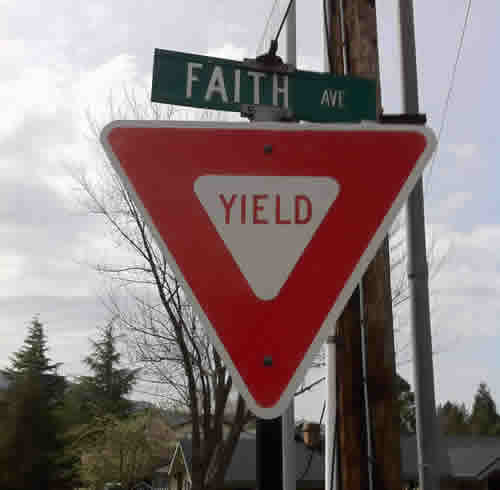
My morning route requires a routine yield to Faith...avenue.... Good practice.
(as long as it's mindful). |
|
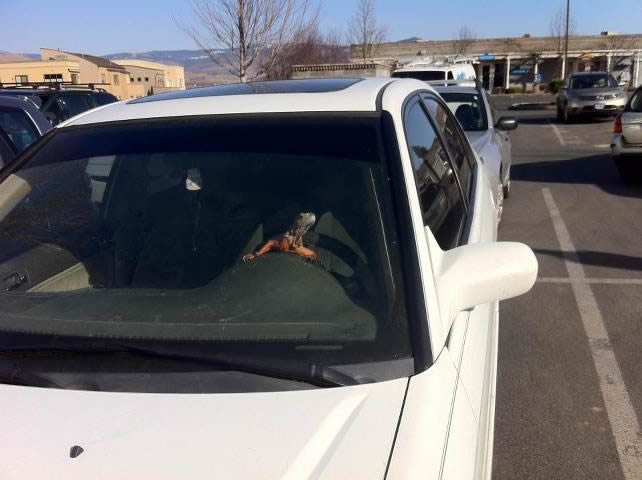
Don't look now Marge, but there's a reptile at the wheel!
Just a reminder that we tend to do a lot better when we use our "whole brains." Our fears and feelings are trapped in our reptilian brains, in the limbic system. When you are feeling overwhelmed by fear, anxiety, panic, you might want to check and see if there's a lizard at the wheel. It might be a great opportunity to use your whole brain.
We tend to navigate difficulties much more elegantly when we can focus on what is happening and use our whole brains, including our sensorimotor cortex which does a good job of exquisitely helping us to sense what is happening. Start noticing what you see, what you hear, what you feel. What can you notice about what is happening. Notice your feet. Can you feel them? I was fascinated by a recent exercise at our recent Feldenkrais intensive. Try it right now.
Once you've read the instructions in this paragraph, close your eyes and put your attention on your feet. Can you notice how your feet are positioned in relation to the rest of you? Can you sense your big toe? Can you sense each of the rest of your four toes, or are they a 'clump?' It's a great argument for toe socks. Sales in Eugene must have skyrocketed last month as all of us clamored to REI to buy them and try them. And how interesting it is to put toe socks on your feet if you sense them as a "clump."
I heard recently that a German study of the human ability to discriminate between discrete sensations has diminished greatly over the last thirty years. It's a good excuse to refrain from grabbing the salt shaker or the ketchup bottle the next time you sit down to a meal. It's also why attending a Feldenkrais Awareness Through Movement Lesson can help you to develop a better brain!
In an Awareness Through Movement Lesson, the goal isn't to carry out the instructions, but to really take time to sense them.When the instructor gives a series of verbal directions, guiding you through a series of movements. Sometimes the challenge is in knowing how soon to begin acting on the directions. Some of us want to rush in and perform right away, yet sometimes it is best to stop and really understand what is being asked, and to imagine doing it before moving a muscle. , how we think of the directions, and developing an awareness of our relationships with our own bodies can help us to do what Moshe Feldenkrais saw as a fine achievement: "To make the impossible possible, the possible easy, and the easy, elegant." |
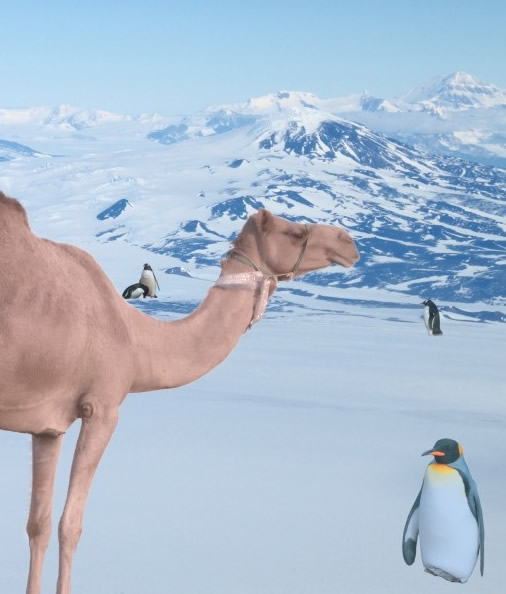
There is a wonderful Rumi poem about a lost camel. The poem starts with the words, "You’ve lost your camel, my friend, and everyone is giving you advice. You don’t know where your camel is, but you do know that these casual directions are wrong."
So often, when we launch ourselves on a new endeavor, there are those people around us who love us and want so much to help when they think we might need direction. When we feel lost, they might want to help set us on the path. The poem goes on to say that some people give advice in order to be part owner of your camel when you find it. At such times, it is important to listen to that small still voice within. The more we can learn to trust our inner brilliance, the less likely we are to have discovered that our camels have been lost.
(or in my case, my car keys... If I can consistently put them where they belong, I can spare myself from hours of hunting frantically!).
Sometimes people can provide us with useful guidance. As the poem goes on, "when good information comes, you know it right away." |
Happy Easter, everyone!
Dear Ones,
I'm continuing to learn so much with each issue of this project. Your feedback has been incredibly helpful for me, and I really appreciate the ideas that have been offered. It helps me as I continue to develop and grow these ideas, and as I have a sense of where to add and what needs more careful editing.
Sincerely,
Liz Towill
Chrysalis Whisperer |
Catalog of previous issues:
Issue #1: Love and Friendship
Issue #2: Compassion and Kindness
Issue #3: Balance
Issue #4: Your Dream Path
Issue #5: Your Creative Calling
Issue #6: Your Oldest Friend
Call today for a free 20 minute consultation! (541) 531-6523
|
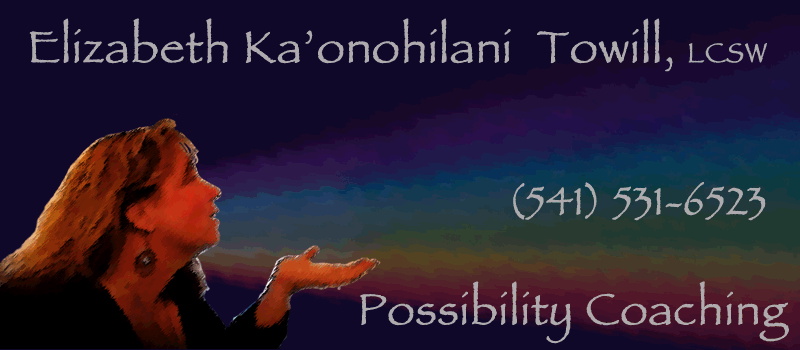
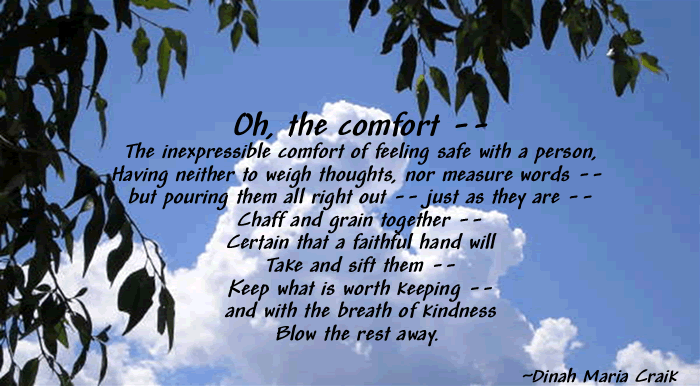

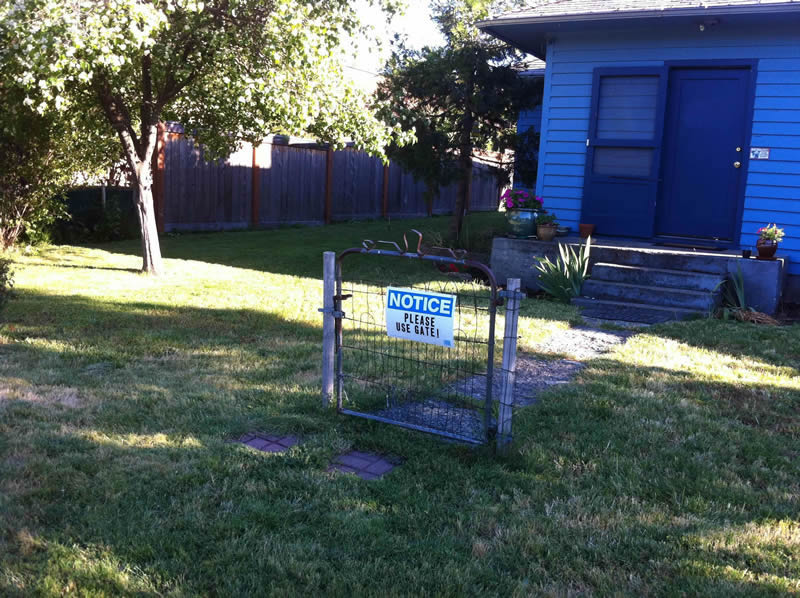



 Sign up for your FREE E*Bouquet from the Chrysalis Whisperer
Sign up for your FREE E*Bouquet from the Chrysalis Whisperer